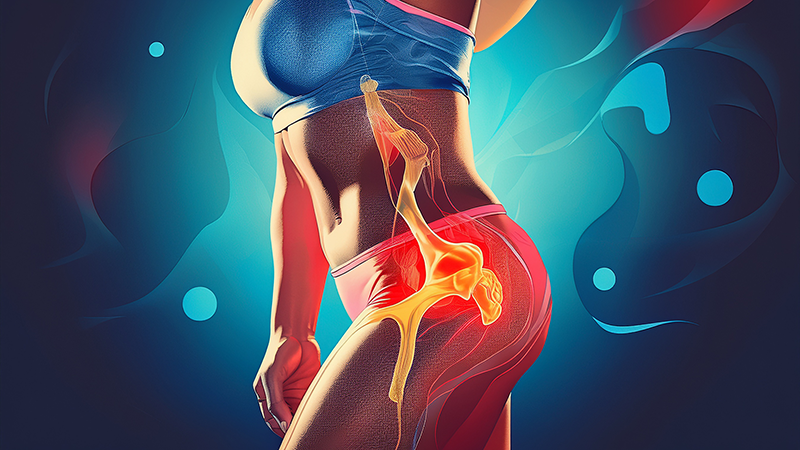
The hip is a vital joint in the human body, playing a central role in mobility and weight-bearing activities. When hip pain arises, it can significantly impact daily life, causing discomfort, limited movement, and difficulty performing even simple tasks. The pain may originate from within the joint or result from injuries affecting surrounding soft tissues. In some cases, pain felt in the hip may stem from issues in the spine or groin.
Common Causes of Hip Pain
Hip pain can result from a variety of conditions, ranging from minor strains to chronic degenerative diseases. Here are some of the most common causes:
1. Osteoarthritis
- A leading cause of hip pain, particularly in middle-aged and older adults.
- Results from cartilage breakdown in the joint, leading to stiffness, inflammation, and limited mobility.
- Progressive condition with no cure, but manageable through conservative and interventional treatments.
2. Bursitis
- Involves inflammation of the bursae, small fluid-filled sacs that cushion the hip joint.
- Often caused by overuse, direct trauma, arthritis, or bone spurs.
- Leads to pain, swelling, and tenderness.
3. Hip Sprains and Strains
- A sprain occurs when the ligaments that stabilize the hip are stretched or torn.
- A strain involves damage to the muscles or tendons around the hip joint.
- Commonly caused by sports injuries, overuse, improper lifting, or sudden movements.
4. Femoroacetabular Impingement (FAI)
- Occurs when bone spurs develop in the hip joint, causing the bones to rub against each other.
- More common in athletes, particularly those involved in high-impact sports.
- Can lead to labral tears and arthritis over time.
5. Hip Labral Tears
- A tear in the labrum, the cartilage lining the rim of the hip joint.
- Causes instability, pain, and limited movement.
- Common in athletes and individuals with structural abnormalities of the hip.
6. Tendonitis and Synovitis
- Tendonitis: Inflammation of tendons, often due to repetitive activities.
- Synovitis: Inflammation of the joint lining, associated with conditions like rheumatoid arthritis.
- Both conditions cause pain, swelling, and restricted movement.
7. Hip Fractures
- More common in older adults due to weakened bones (osteoporosis).
- Requires immediate medical attention and often surgical intervention.
8. Nerve Issues (Sciatica and Pinched Nerves)
- Sciatica occurs when the sciatic nerve is compressed, leading to hip pain radiating down the leg.
- Pinched nerves in the lower back can mimic hip pain symptoms.
Symptoms of Hip Pain
The symptoms vary depending on the underlying condition but may include:
- Pain in the hip, groin, buttocks, thigh, or lower back.
- Swelling, tenderness, or warmth around the joint.
- Reduced range of motion and stiffness.
- Difficulty walking, standing, or performing daily activities.
- Pain worsening with movement or prolonged activity.
- Radiating pain down the leg.
Diagnosing Hip Pain
A thorough diagnosis is crucial to determine the best course of treatment. Physicians typically use the following methods:
- Physical Examination: Assessing pain levels, range of motion, and swelling.
- Imaging Tests: X-rays, MRIs, or ultrasounds to detect fractures, arthritis, or soft tissue injuries.
- Patient History: Understanding how the pain started and identifying risk factors.
Treatment Options
Treatment for hip pain depends on its severity and underlying cause. Options range from conservative therapies to advanced interventional procedures.
Conservative Treatments
- Rest: Avoiding activities that worsen the pain.
- Ice and Heat Therapy: Ice reduces inflammation; heat relaxes muscles.
- Physical Therapy: Exercises to strengthen hip muscles and improve flexibility.
- Pain Relievers: Over-the-counter medications like ibuprofen or acetaminophen.
Interventional Pain Management
For persistent or severe hip pain, interventional procedures offer targeted relief:
- Corticosteroid Injections: Reduce inflammation and provide temporary pain relief.
- Platelet-Rich Plasma (PRP) Therapy: Uses the patient’s own blood plasma to promote healing.
- Nerve Blocks: Targeting specific nerves to alleviate pain and improve mobility.
- Radiofrequency Ablation (RFA): Uses heat to disrupt pain signals from the affected area.
- Prolotherapy: Injection-based treatment that stimulates the body’s natural healing process.
- Fluoroscopic Guided Epidural Injections: Helps reduce pain from nerve compression.
- Spinal Cord Stimulation: Modulates pain signals before they reach the brain.
Rehabilitation and Prevention
Recovery from hip injuries and conditions often requires rehabilitation to restore strength, flexibility, and function. Key components include:
- Stretching and Strengthening Exercises: Improve joint stability and muscle elasticity.
- Gait Training: Correcting improper walking patterns to reduce strain on the hip.
- Hydrotherapy: Water-based exercises to minimize impact on the hip.
- Lifestyle Modifications: Ergonomic adjustments, posture correction, and weight management.
To prevent hip injuries:
- Always warm up and stretch before physical activities.
- Strengthen core and hip muscles.
- Maintain proper posture and ergonomics.
- Wear supportive footwear.
- Listen to your body—avoid overexertion and repetitive stress.
Conclusion
Hip pain can be debilitating, but with the right diagnosis, treatment, and preventive measures, you can regain mobility and live pain-free. From conservative therapies to cutting-edge interventional treatments, medical professionals offer tailored solutions to address the root cause of pain and improve overall quality of life. If you’re experiencing persistent hip pain, seek medical evaluation to determine the best course of action for your recovery.
Precision Pain Care and Rehabilitation has two convenient locations in Richmond Hill – Queens, and New Hyde Park – Long Island. Call the Queens office at (718) 215-1888 or (516) 419-4480 for the Long Island office to arrange an appointment with our Interventional Pain Management Specialists, Dr. Jeffrey Chacko or Dr. Sonny Ahluwalia.
Note: This article is for informational purposes only and should not be considered medical advice. Consult a healthcare professional for personalized recommendations.















